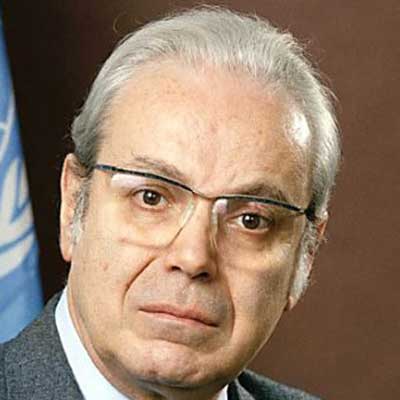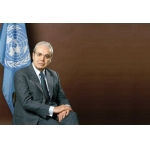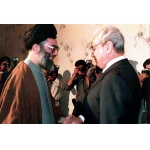Pérez de Cuéllar, Javier
Fatemeh Daftari
344 بازدید
Javier Felipe Ricardo Pérez de Cuéllar de la Guerra (1920–2020) was a Peruvian diplomat and politician who served as the fifth Secretary-General of the United Nations from 1982 to 1991. He made significant diplomatic efforts to end the Iran-Iraq War.
Pérez de Cuéllar was born on January 19, 1920, in Lima, the capital of Peru. He studied law and literature at the University of Lima. Initially, he joined the Ministry of Foreign Affairs in 1940 as an intern. Then, in 1944, he began serving as a third secretary at Peru’s embassy in France. He was a member of the Peruvian delegation to the first session of the United Nations General Assembly, which convened in London in 1946. He later served as the permanent representative of Peru to the UN in 1946 and 1947. After returning to Peru in 1961, he held various positions, including Director-General of Protocol and State Ceremony at the Ministry of Foreign Affairs, university professor, Peruvian Ambassador to Sweden, head of the Department of Political Affairs at the Ministry of Foreign Affairs, Ambassador to the Soviet Union, Permanent Representative to the United Nations, political advisor to the UN Secretary-General, Ambassador to Brazil, and President of the UN Security Council.[1]
Pérez de Cuéllar was sworn in as Secretary-General of the United Nations on January 1, 1982.[2] As he described, the UN at that time was facing various challenges and crises, including the Soviet invasion of Afghanistan, the conflict between Israel and Lebanon over the Golan Heights, and most notably, the intensification of the Iran-Iraq War.[3] Since its onset, Kurt Waldheim, the then UN Secretary-General, sought to halt the war. On September 23, 1980, citing Article 99 of the UN Charter, Waldheim brought to the attention of the Security Council the growing danger this war might pose to international peace and security. In response, the Security Council adopted Resolution 479 (1980), urging Iran and Iraq to immediately refrain from further use of force and to settle their dispute by peaceful means. However, the resolution did not address the withdrawal of Iraqi forces from Iranian territory—large parts of which Iraq had occupied—leading Iran to reject the resolution.[4]
After Pérez de Cuéllar was elected Secretary-General, he vigorously continued pursuing Waldheim’s efforts to resolve the crisis, a task he had already been involved with as Waldheim’s assistant from 1975 to 1981.[5]
Pérez de Cuéllar’s first five-year term as Secretary-General ended in 1986, but he was unanimously re-elected for a second term.[6] By this time, the Security Council had issued eight resolutions aimed at ending the Iran-Iraq War. In 1987, the five permanent members of the Security Council drafted Resolution 598, calling for a ceasefire, the release of prisoners of war, and the withdrawal of both parties to their international borders.[7]
The Islamic Republic of Iran sent a letter to Pérez de Cuéllar indicating its conditional acceptance of the resolution. Subsequently,[8] the UN Secretary-General traveled to Iran on September 11, 1987. During his visit, Ayatollah Khamenei, the then-president of Iran, called for the formation of an impartial committee to investigate and identify the aggressor.[9]
In response, Pérez de Cuéllar put forward a plan on October 15, 1987, known as the “Secretary-General’s Implementation Plan,” which Iraq rejected.[10] As Pérez de Cuéllar recounts in his memoirs, the resolution, instead of easing tensions in the region, escalated them.[11]
On December 24, 1987, the Security Council issued another statement urging the Secretary-General to continue his efforts to implement the resolution.[12] Finally, after persistent efforts by the United Nations, Iran accepted the resolution on July 17, 1988. On August 20, 1988, following a meeting held between the foreign ministers of Iran and Iraq, with Pérez de Cuéllar acting as a mediator, a ceasefire was declared.[13]
With the ceasefire in place, Pérez de Cuéllar made significant efforts to ensure its complete implementation, including the first clause of Resolution 598, which called for the withdrawal of both sides to their international borders. At his request, negotiations between the foreign ministers of the two countries began in Geneva on August 25, 1988. However, due to Iraq’s non-cooperation, Iran requested that the negotiations continue under the UN Secretary-General’s supervision in New York, starting on October 1, 1988.[14]
After two rounds of negotiations, with Iraq constantly asking for more talks, a new round of discussions was held in Geneva on November 1, 1988, with Pérez de Cuéllar in attendance. After seven rounds of negotiations, unresolved issues led to another trilateral meeting held on February 17, 1989, in New York, again under the Secretary-General’s supervision. Despite resuming talks in Geneva on April 20, 1989, the negotiations remained inconclusive.[15]
The state of “neither war nor peace” persisted between the two nations until August 14, 1990, when Saddam Hussein announced that Iraq would accept Iran’s proposal to abide by the 1975 Algiers Agreement and begin the withdrawal on August 17.[16]
In his memoir “Pilgrimage for Peace,” Pérez de Cuéllar talks about his efforts to resolve the Iran-Iraq War in a chapter titled “The Endless War.” In 1987,[17] he was awarded the “International Understanding Award” for his peace efforts. In his acceptance speech, he expressed his gratitude to the Iranian officials who had placed their trust in him throughout the negotiations.[18]
On December 9, 1991, Pérez de Cuéllar submitted a report to the Security Council formally identifying Iraq as the aggressor in the Iran-Iraq War.[19] On January 1, 1992, he was succeeded by Boutros Boutros-Ghali of Egypt. He was later appointed head of UNESCO’s World Commission on Culture and Development.[20]
From November 22, 2000, to July 28, 2001, Pérez de Cuéllar served as Prime Minister of Peru. In 2004, he was appointed Peru’s ambassador to France. Javier Pérez de Cuéllar passed away at the age of 100 on March 4, 2020.[21]
[1] Mirsaeed Ghazi, Ali, Biographies of the Secretaries-General of the United Nations and their Political Activities, Tehran: Mobtekaran, 2014, pp. 223 and 224.
[2] Ibid., p. 227.
[3] Ibid., p. 232.
[4] Ibid., p. 234.
[5] Ibid., p. 234.
[6] Ibid., p. 239.
[7] Ibid., p. 244.
[8] Doroudian, Muhammad, A Journey through the Iran-Iraq War, Vol. 5: The End of the War, Tehran: Center for War Studies and Research of the Islamic Revolutionary Guard Corps, 1999, p. 147.
[9] Ibid., p. 151.
[10] Ibid., p. 153.
[11] Pérez de Cuéllar, Javier, Towards Peace, translated by Hamidreza Zahedi, Tehran: Information Publications, 1999, p. 256.
[12] Doroudian, Muhammad, A Journey through the Iran-Iraq War, Vol. 5: p. 155.
[13] Mirsaeed Ghazi, Ali, Biographies of the Secretaries-General of the United Nations and their Political Activities, p. 246.
[14] Doroudian, Muhammad, A Journey through the Iran-Iraq War, Vol. 5: pp. 235-237.
[15] Ibid., pp. 244 and 245.
[16] Ibid., p. 278.
[17] Pérez de Cuéllar, Javier, Towards Peace, 1999
[18] Mirsaeed Ghazi, Ali, Biographies of the Secretaries-General of the United Nations and their Political Activities, p. 248.
[19] Pérez de Cuéllar, Javier, Towards Peace, p.280.
[20] Sajedi, Ahmad, political celebrities of the 20th century, Tehran: Mihrab Qalam, 1995, p. 199.
[21] Iran newspaper, No. 7297, 2020, March, 7, p. 4.





